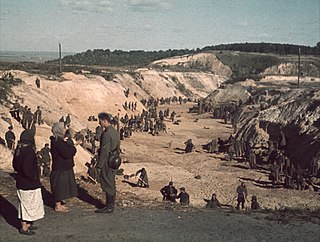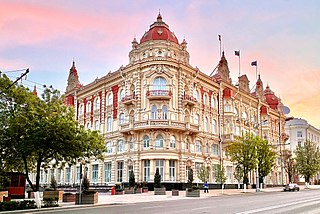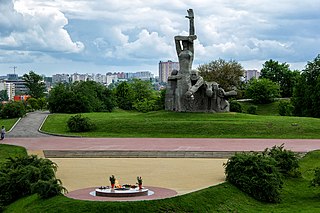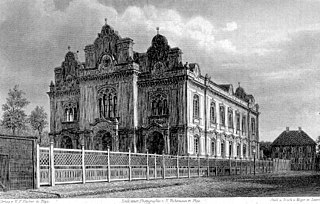
The history of the Jews in Rostov-on-Don dates to at least 1811. Rostov-on-Don was part of the Pale of Settlement until 1888, after which it was included in the military area of the Don Cossacks. [1]

The history of the Jews in Rostov-on-Don dates to at least 1811. Rostov-on-Don was part of the Pale of Settlement until 1888, after which it was included in the military area of the Don Cossacks. [1]
The Rostov fortress and settlement were founded in 1761, and the town gained official status in 1796. The Jewish community remained small until the Poliakov brothers (Samuel, Lazar, and Yakov) built several railroads and transformed Rostov-on-Don into a major transportation center. By 1880, the Jewish population had increased to 5,000. The Jewish community continued to grow, reaching a height of 27,039 people in 1939. During the Holocaust, the Nazi Germans murdered 13,000 Jews at Zmievskaya Balka on 11 August 1942. Several days later, 2,000–5,000 Jews were shot to death in the local Jewish cemetery. During the Soviet era, the Jewish population steadily decreased between the 1950s and the 1990s, and by 2002 less than 5,000 remained in Roston-on-Don. [2]
For many years, the Jewish community of Rostov-on-Don has sought to document and memorialize the city's Holocaust victims. An official monument in Rostov-on-Don does not mention Jewish people, only referring to "peaceful citizens of Rostov-on-Don and Soviet prisoners-of-war". An older plaque mentioning Jews was removed and placed at the Zmiyevskaya Balka memorial hall. The Russian Jewish Congress has pursued legal action to ensure that Jews are named in Holocaust memorialization. Russian authorities have opposed the efforts of the Jewish community. [3] [4]
In 2012, Rostov-on-Don had a Jewish community of around 10,000 people. The city government gave the Main Choral Synagogue a parcel of land adjacent to the synagogue so the community could build a Jewish community center. The city is also home to Chesed Sholom Ber, a Jewish social welfare organization, as well as to Ohr Avner Chabad, a Jewish elementary school. [5]

Babi Yar or Babyn Yar is a ravine in the Ukrainian capital Kyiv and a site of massacres carried out by Nazi Germany's forces during its campaign against the Soviet Union in World War II. The first and best documented of the massacres took place on 29–30 September 1941, in which some 33,771 Jews were murdered. Other victims of massacres at the site included Soviet prisoners of war, communists and Romani people. It is estimated that a total of between 100,000 and 150,000 people were murdered at Babi Yar during the German occupation.

Rostov-on-Don is a port city and the administrative centre of Rostov Oblast and the Southern Federal District of Russia. It lies in the southeastern part of the East European Plain on the Don River, 32 kilometers (20 mi) from the Sea of Azov, directly north of the North Caucasus. The southwestern suburbs of the city lie above the Don river delta. Rostov-on-Don has a population of over one million people and is an important cultural centre of Southern Russia.

The history of the Jews in Moldova reaches back to the 1st century BC, when Roman Jews lived in the cities of the province of Lower Moesia. Bessarabian Jews have been living in the area for some time. Between the 4th-7th centuries AD, Moldova was part of an important trading route between Asia and Europe, and bordered the Khazar Khaganate, where Judaism was the state religion. Prior to the Second World War, violent antisemitic movements across the Bessarabian region badly affected the region's Jewish population. In the 1930s and '40s, under the Romanian governments of Octavian Goga and Ion Antonescu, government-directed pogroms and mass deportations led to the concentration and extermination of Jewish citizens followed, leading to the extermination of between 45,000-60,000 Jews across Bessarabia. The total number of Romanian and Ukrainian Jews who perished in territories under Romanian administration is between 280,000 and 380,000.

The history of the Jews in Latvia dates back to the first Jewish colony established in Piltene in 1571. Jews contributed to Latvia's development until the Northern War (1700–1721), which decimated Latvia's population. The Jewish community reestablished itself in the 18th century, mainly through an influx from Prussia, and came to play a principal role in the economic life of Latvia.

The Ponary massacre, or the Paneriai massacre, was the mass murder of up to 100,000 people, mostly Jews, Poles, and Russians, by German SD and SS and the Lithuanian Ypatingasis būrys killing squads, during World War II and the Holocaust in the Generalbezirk Litauen of Reichskommissariat Ostland. The murders took place between July 1941 and August 1944 near the railway station at Ponary, a suburb of today's Vilnius, Lithuania. 70,000 Jews were murdered at Ponary, along with up to 2,000 Poles, 8,000 Soviet POWs, most of them from nearby Vilnius, and its newly formed Vilna Ghetto. Along with 90 LTDF officers who refused to carry orders by the Germans after the Battle of Murowana Oszmianka.

The Holocaust in Latvia refers to the crimes against humanity committed by Nazi Germany and collaborators victimizing Jews during the occupation of Latvia. From 1941 to 1944, around 70,000 Jews were murdered, approximately three-quarters of the pre-war total of 93,000. In addition, thousands of German and Austrian Jews were deported to the Riga Ghetto.
The Jelgava massacres were the killing of the Jewish population of the city of Jelgava, Latvia that occurred in the second half of July or in early August 1941. The murders were carried out by German police units under the command of Alfred Becu, with a significant contribution by Latvian auxiliary police organized by Mārtiņš Vagulāns.

Krupki is a town in Minsk Region, Belarus. It serves as the administrative center of Krupki District. As of 2024, it has a population of 8,410.

The burning of the Riga synagogues occurred in 1941, during the first days of the World War II Nazi German occupation of the city of Riga, the capital and largest city in the country of Latvia. Many Jews confined in the synagogues died in the fires. Many other anti-Semitic measures were launched at the same time, ultimately followed by the murder of the vast majority of the Jews of Latvia.

The Brześć Ghetto or the Ghetto in Brest on the Bug, also: Brześć nad Bugiem Ghetto, and Brest-Litovsk Ghetto was a Nazi ghetto created in occupied Western Belarus in December 1941, six months after the German troops had invaded the Soviet Union in June 1941. Less than a year after the creation of the ghetto, around October 15–18, 1942, most of approximately 20,000 Jewish inhabitants of Brest (Brześć) were murdered; over 5,000 were executed locally at the Brest Fortress on the orders of Karl Eberhard Schöngarth; the rest in the secluded forest of the Bronna Góra extermination site, sent there aboard Holocaust trains under the guise of 'resettlement'.
Babi Yar, a ravine near Kyiv, was the scene of possibly the largest shooting massacre during the Holocaust. After the war, commemoration efforts encountered serious difficulty because of the policy of the Soviet Union. After the dissolution of the Soviet Union, a number of memorials have been erected. The creation of the Babyn Yar Holocaust Memorial Center was initiated in 2016.

Zmievskaya Balka, Zmiyovskaya Balka is a site in Rostov-on-Don, Russia at which 27,000 Jews and Soviet civilians were massacred in 1942 to 1943 by the SS Einsatzgruppe D during the Holocaust in Russia. It is considered to be the largest single mass murder site of Jews on Russian territory during the Second World War. The name means "the ravine of the snakes".

Gully of Petrushino is a site on the outskirts of Taganrog, Russia, at which 7,000 Soviet civilians, mostly Jews, were massacred between 1941 and 1943 by the German army, with the assistance of non-German divisions, during their occupation of Taganrog.
The following is a timeline of the history of the city of Rostov-on-Don, Russia.

The Tarnopol Ghetto was a Jewish World War II ghetto established in 1941 by the Schutzstaffel (SS) in the prewar Polish city of Tarnopol.
The Sarny Massacre was the execution of an estimated 14,000 to 18,000 people, mostly Jews, in the Nazi-occupied Polish city of Sarny on August 27 and 28, 1942.

Tamara Vasilyevna Pletnyova is a Russian politician.
The history of the Jews in Kharkiv dates to at least 1734, when the Russian Empire allowed Jewish merchants to visit the city to engage in retail and trade. Unusual for major Ukrainian cities, there were no pogroms in Kharkiv during the Tsarist era.

The Jewish community of Riga, Latvia, began to exist in the 17th century and was interrupted several times due to the expulsion of the city's Jews. The number of Jews in the city grew significantly during the 19th century, reaching a peak before the Holocaust.